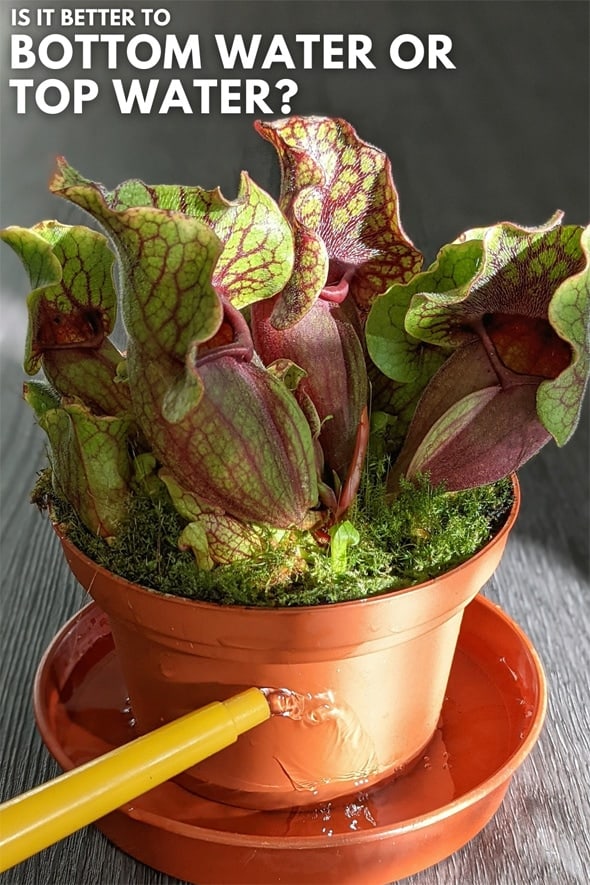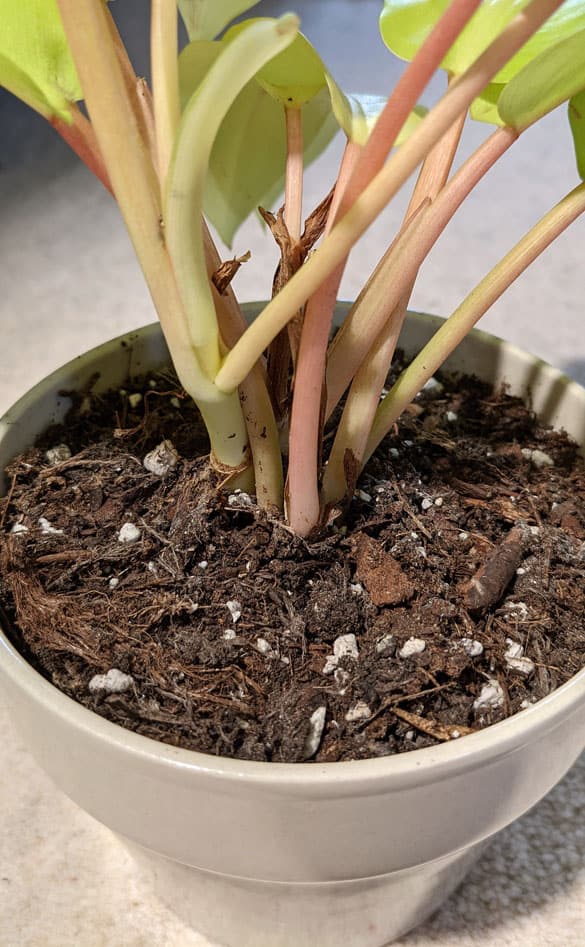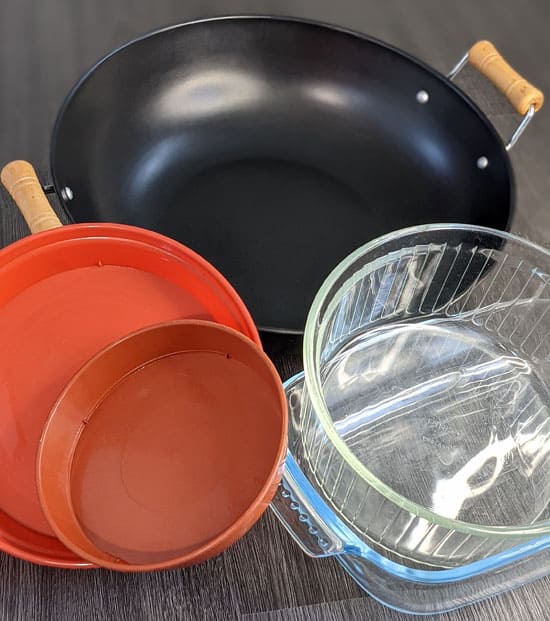Generally speaking, it makes no real difference whether you top water or bottom water your plants.
All houseplants really want from you is sufficient water around their roots. As well as a small reserve of water to be "held" in the surrounding growing medium, that they can access in the coming days or weeks.
Is this the best way to water a potted plant?
Whether you provide water from the top or the bottom doesn't usually matter in the grand scheme of things. But there are advantages, disadvantages and myths around this practice. We're going to go through all these shortly.
"Top watering" means you provide water to the top of the plant's soil surface. Then with the help of gravity, the water will seep down through the growing medium right to the bottom of the pot.
"Bottom watering" is when you pour water into a vessel, like a container or a drip tray, and then sit the plant and its pot into it for a short time.
The water is pulled upwards into the dry growing medium by capillary action. If there is enough water in the vessel, all of the growing media will eventually be saturated.
If done correctly the result of each type of watering is exactly the same. Your plant is well watered and there is sufficient moisture around the roots to keep it going until you need to do it all over again.
Use the slider above to tap / swipe back and forth to see the difference between Bottom Watering vs Top Watering.

Hi, I'm Tom!
If you're like me and enjoy the challenge of growing houseplants and getting them to thrive, then Ourhouseplants can help. This website shares my knowledge and years of growing plants and provides (hopefully) helpful advice on properly caring for your indoor plant friends.
Sometimes there is a genuine benefit or requirement to top or bottom water your plants, and we look at these later. However, in most cases, it's down to personal preference.
Often someone telling you that you must do it a certain way is perpetrating one of the common myths. Here are three of the most popular reasons given along with more detail and context.
1
This one is entirely false and really makes no sense at all when you think about it.
And here's why.
The reality of this claim
In this example, "plants only absorb the water they need" really means "the potting mixture will absorb as much water as it can hold".
The plant hasn't absorbed the water. The potting mix has.
Plants will never immediately "drink" or use all the water you add to the potting mix.
Much like a battery is designed to absorb and store energy for later use, the primary purpose of watering is to "recharge" the dry growing medium with moisture.
The roots will then access this moisture as and when they need it, ideally for a few days, a week or even longer.
When you water a plant, of course you're wetting the soil and roots simultaneously, and a tiny amount of this will start to be absorbed by the plant immediately.
How the water gets into the growing medium, either from the top of the pot or its bottom, doesn't make any difference. The roots will only ever absorb the amount of water they need in that given moment. Bottom watering will never change that.
2
Most plant parents are encouraged to use pots with drainage holes in the bottom. This is one of the very best ways to prevent overwatering and root rot, as excess water will simply drain out of the holes and can then be poured away.
If you're bottom watering the idea is that after the growing medium has been fully wetted, you lift the pot, let any excess water drip out, and then put it back into its outer container.
Yes, this likely would help prevent overwatering. But equally, if you chose to top water, you would just wait half an hour and then lift the pot from the outer container. If there is water at the bottom, you will then pour this away. The exact same thing!
So this one has definitely has elements of truth to it. But it's not a compelling reason to bottom water houseplants exclusively.
Further reading -
Are you overwatering your plants? - The Signs to look out for
3
This originates from gardeners' advice that you should water new outdoor plants heavily and deeply, rather than "little and often".
The view is that by doing this, you will encourage roots to grow deeper into the soil to reach the moisture deep down and this helps prevent excessive shallow roots and provides resilience in times of drought.
When gardening outdoors, I understand this reasoning as the roots have lots of choices about where they can grow and you can help control this.
With Indoor gardening it's different because plants are confined into relatively small pots. So regardless if you choose to top or bottom water the roots will still grow strongly and eventually fill the entire pot due to gravitropism.
Sometimes there is a genuine need or benefit to top water your houseplants.
Bottom watering can have some advantages over top watering. Here are 4 examples when it can work well.
The top of the soil is dry, but an inch or so down and you'll find moist soil.
All you need is for your plant to be growing in a container or pot with drainage holes. Then grab a vessel, it could be a saucer or a large dish. Even a wok would work!
Fill this vessel with room temperature water and then lower the plant into the water. Leave it for at least five minutes to give it time for the soil to suck up water, but ideally not longer than an hour or so.
How long each plant needs in this "water bath" will vary, but it's ready to be taken out as soon as the upper surface becomes damp.
Remove the plant and give it something like 30 seconds for any excess water to drain / drip out. And that's it, job done.
Simple drip trays or larger containers can all be filled with a few inches of water to help you water your houseplants.
If you've read this entire article, you should hopefully already know that top watering vs bottom watering will typically come down to personal preference. Just do what's easier for you or takes less time!
There are occasional instances where one of these watering methods will be better than the other and doing this will likely help you keep your plants healthy or resolve a problem.
I almost always water using the top method. The primary benefit is time saving and less effort. I have a lot of houseplants, including a good number of thirsty tropical plants and some heavy larger plants.
Top watering vs bottom watering will normally come down to personal preference.
Setting up a bottom watering station every few days and bringing all of them to the station would take forever. So by me going to each plant with a watering can it's much quicker and more efficient.
That said there are two very important benefits of bottom watering which I'll vouch for though. The first is bottom watering to help deal with Fungus Gnats, of which I've had moderate success over the years.
I also like doing it with plants in very porous potting mixes like Moth Orchids, especially when I'm trying to apply feed (add it to the container of water before dunking your plants in it). This gives the bark mix time to soak it up evenly and restores moisture levels, meaning I need to water them less often.


